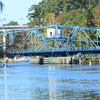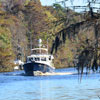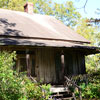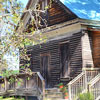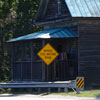Socastee Historic District
Clustered around the Socastee Swing Bridge which spanned the last link of the Intracoastal Waterway in 1936, the Socastee Historic District includes Socastee United Methodist Church, established in 1818, a landmark pecan grove, various historic homes, and the T.B. Cooper General Store, built in 1905, which served as the first post office for the fledgling resort of Myrtle Beach.
Photo Gallery
Click icon to enlarge image. Use arrow keys or
click large picture to cycle through the gallery.
|
Socastee Historic District
Itinerary
Add This Site to Your Itinerary
Site Description
The unincorporated Socastee community derives its name from a local swamp and creek which are believed to borne an Indian name - "Sawkastee" - in the early Colonial Era. Settled by scattered English immigrants prior to the American Revolution, the area became a source of timber and naval stores - tar, pitch and turpentine - from the Colonial Era well into the 19th century. As many people or more worked in the naval stores industry as in farming during much of Horry County's history.
By 1873, the community was bustling. Along with scattered farms, it boasted three turpentine stills, a cooper's store, a cotton gin, and a new mercantile store established by local merchants J.E. Dusenbury and Samuel Sarvis. At the beginning of the 20th century, when technology changed the world's navies and naval stores declined, timber and farming continued in Socastee. At nearby Peachtree Landing, one of the region's most active wooden ferries transported early beachgoers bound for Murrells Inlet and Pawleys Island across the Waccamaw River. As Myrtle Beach developed into a major resort in the 20th century, Socastee's population and commerce likewise increased, although it retained Horry County's rowdy frontier reputation through the mid-20th century. The final link of the Intracoastal Waterway was constructed through Socastee in the 1930s and when completed 1936, the feat was commemorated in a dedication headed by U.S. Secretary of the Interior Harold L. Ickes. The historic bridge is located where Dick Pond Road crosses the Waterway adjacent to Highway 544 and the modern Ben Thrailkill Bridge. It has been retooled and restored, but the original bridge tender's box from 1936 is still located on site. On the west side of the historic bridge, on Dick Pond Road, stands T.B. Cooper's General Store. From 1905 to 1930, the store not only provided feed, grain, coffee, soda pop and popular store-bought wares to Socastee residents, but it also served as the first post office for Myrtle Beach. Traveling by automobile to Myrtle Beach from the west in the resort's early days meant taking a circuitous route from Conway to Myrtle Beach that passed through Socastee - where early Myrtle Beach residents had to pick up their mail. The store sits at the edge of a historic stand of pecan trees. Nearby, adjacent to a modern sanctuary, is the late 19th century structure that housed what is now Socastee United Methodist Church which originally held services in a log cabin built in 1818. Remodeled in 1957, the white-paneled, late-19th-century structure was built in 1875 and retains elements of its 19th century design. The church, store, bridge, pecan grove, and several nearby houses now constitute the Socastee Historic District. |
